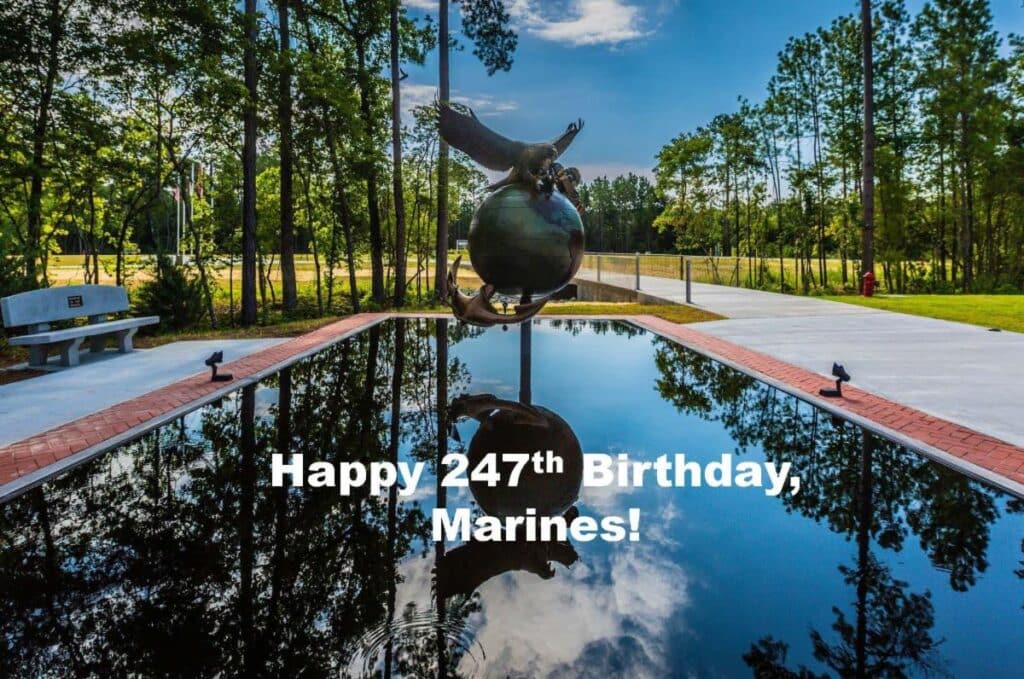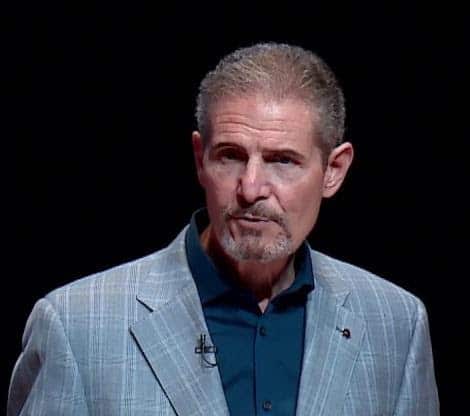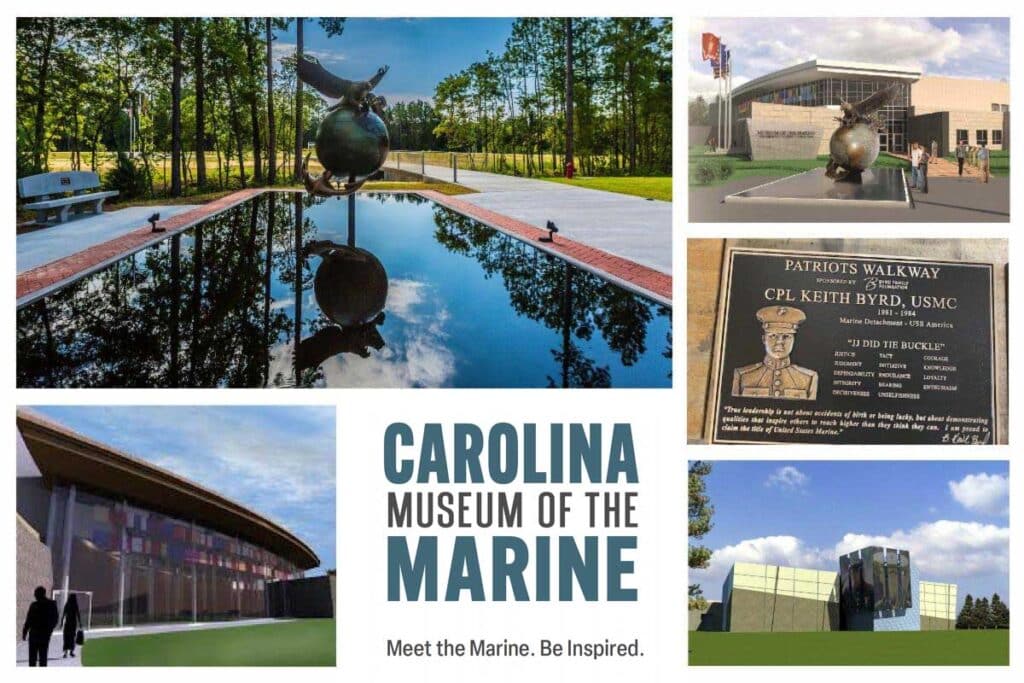Front and Center Vol 1 No 11 November 2022

FRONT AND CENTER
Vol. 1, No 11, November 2022

Mission
Honoring the legacy of Carolina Marines and Sailors and inspiring future generations.
A Message from the CEO
As I reflect on the mission of the Carolina Museum of the Marine, it is awe inspiring and it is a privilege to be part of this great team. There is a saying that fits us well, “For a Cause to be Just, it Must be Durable, Resilient, and Timeless”. This is why we have such tremendous confidence in our actions to build a world-class museum…and it is exciting!
Our new website (www.museumofthemarine.org) continues to receive positive reviews and we recently added some new videos to our online “Memory Zone” and the Al Gray Marine Leadership Forum’s Valor and Virtue page that are worth checking out for a little motivation.
If you are thinking of buying a new vehicle, November is the month to do it. We have partnered with several local auto dealerships, and they are donating to us for every car sold. Please check our website for participating dealerships.
Our website is a great resource and it will soon be home to a variety of courses under development for the Al Gray Marine Leadership Forum.
We continue to make great progress and we are focused on building the “team” of architects, contractors, and designers that will build a museum that we are all proud of. There is lots of work to do in this area, and the momentum is growing. Stay tuned and thank you for your continued support.


BGen Kevin Stewart, USMC (Ret)
Chief Executive Officer
Never Forget…

23 October 2022 – Beirut Memorial Observance. 29th Commandant General Al Gray, USMC (Ret) addresses the families of the survivors of the Beirut bombings thirty-nine years ago. More than four hundred people gathered to pay respect to those who lost their lives in service to our nation. Photo by City of Jacksonville.
In Their Own Words…
WHAT IS HONOR?
Al Gray Marine Leadership Forum Essays
The intent of these essays is to create civil discourse and spur thought. In line with our mantra of “teaching how to think, not what to think” these essays are complex, and the issues addressed are difficult to navigate without sparking some disagreements.
We welcome this, as we work to inspire principled and committed leaders.
On the Founding Principles of the United States:
The English Bill of Rights
by James Danielson, PhD
When Americans were debating whether to ratify our Constitution, one of the disagreements that animated them was whether to include a bill of rights. James Madison argued against, holding that the purpose of a bill of rights is to restrain tyrants and that the general government proposed in the Constitution is not a sovereign power able to exploit citizens, but rather an agent of the sovereign states that created it. The general government has only those powers delegated to it in the Constitution and nothing more. Thus a bill of rights would not add to our security, but it could become a focus of contention as scheming people will assert that the rights in the bill of rights are the only rights possessed by the people. Thomas Jefferson argued in favor, holding that a bill of rights will give to Americans a common language in which to discuss the political implications of our rights. Several states insisted they would not ratify the Constitution without assurances of a bill of rights quickly to follow. James Madison relented and agreed to draft a bill. Interestingly, one can argue that Madison is not the father of the Constitution since his Virginia Plan was mostly shot down at Philadelphia in 1787, and the government contrived in the Constitution is not the nationalist model Madison wanted. But he is doubtless the father of the Bill of Rights, and his work here is influenced by the English Bill of Rights of 1689.

Wikimedia.org

by Rembrandt Peale.
Wikimedia.org
The English Bill of Rights is a basic document of the British constitution alongside such documents as Magna Carta, the Petition of Right, and the Habeas Corpus Act of 1679. By 1689, the English were well into a contentious development away from executive rule by kings and queens and toward Parliamentary rule and a recognition of rights held by the people. Many analysts of this development contend that the English Bill of Rights is influenced by the political philosophy of John Locke, which is likely to be true, but there is disagreement about what Locke was up to, especially in his Treatise of Civil Government. Locke asserts that each human being owns him- or herself, and because we each own ourselves, we are not to be used by others without our consent, and we naturally own the products of our labor. At the same time, Locke holds a conception of sovereign government that is in line with that of the 17th century English political philosopher Thomas Hobbes, advanced most famously in his 1651 book Leviathan, which 20thcentury English philosopher Michael Oakeshott called the most important work on political philosophy written in English. Hobbes argues that in a state of nature, which is a condition without a civil government, there are no moral obligations except to live in peace with anyone willing to live peacefully with you. Where others are not willing to do this, we are at liberty to do anything at all to them we think will effect our security. This primordial condition of humanity prevents salutary cooperation, since no one is willing to produce wealth lest others kill him for it. To overcome this, Hobbes argues, people will surrender their right to use force against others to a sovereign power, and in return the sovereign protects us from violence, foreign and domestic, and enforces our contracts one with another. This, in brief, is the structure of the “social contract.” We should observe that on Hobbes’ account of the state, the people may consent to establish a sovereign government one time only, after which disobedience or attempts to leave are treason, a capital crime. This, however, is not part of the American political tradition that produced the Constitution of the United States in 1787. Treason against the United States is defined in Article III, section 3 of the Constitution and consists only in levying war against them, or in adhering to their enemies, giving them aid and comfort. Thus in the American political tradition, as explained in the Declaration of Independence, the people of the states are sovereign political societies within each state, and thus possess the right to alter or abolish abusive government and to fashion new government to protect their safety and happiness.
One might notice that Hobbes’ view of legitimate government does not fit well with Lockean self-ownership and the right to the products of one’s labor. In practice, however, whatever rights we might have by nature are not always the rights a political society chooses to protect. The rights we each will enjoy in fact are the rights most dear to the people to whom we belong, for these are the rights a people will protect. This is why the sorts of rights Americans advocated in our colonial and early republican history are those we see developing in early modern England. We might then attend briefly to some of these rights that have been influential for Americans.
The English Bill made it illegal for the executive power (the king) to spend money without consent of the legislature (Parliament). Moreover, the executive cannot levy taxes on the people; this is the power of the elected legislature. The people have the right to petition the executive for redress of grievances, and any attempt to punish such acts is illegal. The Bill made it illegal for the king to maintain a standing army in peacetime without consent of the Parliament. This issue, whether to maintain a standing army in peacetime, was a very serious concern during the ratification debates for our Constitution because Americans saw in a standing army the means of their oppression by tyrannical governments. The sword, the argument goes, is to be held by state militias who in time of emergency protect the country while an army is raised, and the army is to be disbanded when the emergency passes. Lastly, this should be familiar to all of us: “Excessive bail ought not to be required, nor excessive fines imposed, nor cruel and unusual punishments inflicted.”

In these rights we see enshrined, not only in our Bill of Rights, but also in Article I of the Constitution that sets out the powers delegated to Congress, and in Article II that establishes the authority, and limits thereto, of the executive, ideas that came to North America with the English settlers in the 17th century, and which remain vital today. We conclude with an admonition given to Americans by President Jefferson in his first inaugural address in 1801.
Having set out what he found to be the basic principles of American political order, Jefferson says: “These principles form the bright constellation, which has gone before us and guided our steps through an age of revolution and reformation.
The wisdom of our sages, and blood of our heroes have been devoted to their attainment:—they should be the creed of our political faith; the text of civic instruction, the touchstone by which to try the services of those we trust; and should we wander from them in moments of error or of alarm, let us hasten to retrace our steps, and to regain the road which alone leads to peace, liberty and safety.”
Happy Birthday from MajGen John A. Lejeune

On November 1, 1921, John A. Lejeune, 13th Commandant of the Marine Corps, directed that a reminder of the honorable service of the Corps be published by every command, to all Marines throughout the globe, on the Birthday of the Corps. Since that day, Marines have continued to distinguish themselves on many battlefields and foreign shores, in war and peace. On this Birthday of the Corps, therefore, in compliance with the will of the 13th Commandant, Article 38, United States Marine Corps Manual, Edition of 1921, is published as follows:
(1) On November 10, 1775, a Corps of Marines was created by a resolution of the Continental Congress. Since that date many thousands of men have borne the name Marine. In memory of them it is fitting that we who are Marines should commemorate the Birthday of our Corps by calling to mind the glories of its long and illustrious history.
(2) The record of our Corps is one which will bear comparison with that of the most famous military organizations in the world’s history. During 90 of the 146 years of its existence the Marine Corps has been in action against the Nation’s foes. From the Battle of Trenton to the Argonne, Marines have won foremost honors in war and in the long eras of tranquility at home, generation after generation of Marines have grown gray in war in both hemispheres, and in every corner of the seven seas so that our country and its citizens might enjoy peace and security.
(3) In every battle and skirmish since the Birth of the Corps, Marines have acquitted themselves with the greatest distinction, winning new honors on each occasion until the term “Marine” has come to signify all that is highest in military efficiency and soldierly virtue.
(4) This high name of distinction and soldierly repute we who are Marines today have received from those who preceded us in the Corps. With it we also received from them the eternal spirit which has animated our Corps from generation to generation and has long been the distinguishing mark of Marines in every age. So long as that spirit continues to flourish Marines will be found equal to every emergency in the future as they have been in the past, and the men of our nation will regard us as worthy successors to the long line of illustrious men who have served as “Soldiers of the Sea” since the founding of the Corps.”The inspiring message of our 13th Commandant has left its mark in the hearts and minds of all Marines. By deed and act from Guadalcanal to Iwo Jima, from Inchon to the Korean Armistice, in interventions from Lebanon to the Dominican Republic, and from the opening battles of Vietnam to the Mayaguez rescue, Marines have continued to epitomize those qualities which are their legacy. The success which they have achieved in combat and the faith they have borne in peace will continue. The Commandant and our many friends have added their hearty praise and congratulations on this our 146th birthday.
Welcome New Board Members!
Carolina Museum of the Marine elected new officers and new board members at its annual meeting on 12 October 2022.
Welcome to the team! We look forward to working together to build a world-class museum that every Marine, Sailor and citizen is proud of.

Mr. Keith Byrd enlisted in the Marine Corps in 1981 and proudly served his country until 1984. Following his military service, he became a NC State Highway Patrol Trooper. From there, he worked in varying upper level management positions at UPS for 20 years before co-founding Transportation Impact, a logistics business in Emerald Isle, NC, in 2008. Keith currently serves as their Chairman of the Board of Directors.
Keith and his wife, Ginger, reside in Marco Island, Florida but visit eastern North Carolina regularly to visit with his family, who all reside locally.
Although Keith continues to work with the company he founded, as well as in real estate development, he remains dedicated to supporting the growth of the Carolina Museum of the Marine. He believes the Marine Corps is and will always be vital to the health and well-being of the United States of America and is proud to support this belief with his new position as a member of the Carolina Museum of the Marine Board of Directors.

Lieutenant General William Mark Faulkner is the President of the Institute for Defense and Business (IDB) and serves as the Executive Director of IDB’s Center of Excellence in Logistics and Technology (LOGTECH). He was most recently the President and Chief Executive Officer of the Marine Corps Association. The Marine Corps Association is the professional association of the Marine Corps and is a Military Service Association 501 (c)(19) with a supporting Public Charity 501 (c)(3).
General Faulkner served at Headquarters Marine Corps in the Pentagon as the Deputy Commandant for Installations and Logistics prior to his retirement in 2015. He previously served as the Vice Director, J-4, Joint Staff. He commanded both 2d and 3d Marine Logistics Groups and served as the Chief of Staff, 2d Marine Logistics Group (Forward) in support of Operation Iraqi Freedom 06-08.

Mr. Frank Guidara, a decorated veteran of the United States Army who served as a 1st Lieutenant in Vietnam, is a well known entrepreneur and restauranteur who served as the President and CEO of Restaurant Associates with restaurants in Rockefeller Center, Met Life Building, Brasserie, Mama Leone’s, Lincoln Center, Kennedy Center, LA Music Center, United Nations, Metropolitan Museum of Modern Art (NYC), Museum of Natural History (NYC), and US Open Tennis among others.
Guidara also served as President and CEO of Wolfgang Puck Food Company, Au Ban Pain, and Pizzeria Uno prior to his retirement in 2012. He serves on the boards of Not Your Average Joe’s, E3 Chophouse, and Captain D’s. He is a graduate of University of Massachusetts and is a member of 1st Cav Division / Angry Skipper Association, and an active supporter of 160th Nightstalkers.

Col Bob Love, USMC (Ret) served as a member of the Senior Executive Service under three presidential administrations including Bush, Obama and Trump, most recently serving as the Chief of Staff and Senior Executive to the 33rd Under Secretary of the Navy and to two Secretaries of the Navy (2018-2020). Love received the Navy Distinguished Civilian Service Award, the highest civilian award given by the Secretary of the Navy.
Love is currently the Vice President, Defense Logistics and Naval Services at the Logistics Management Institute. He is also a town council member for Town of Occoquan, VA.
Love retired as a colonel in the United States Marine Corps in 2004. His military career included a variety of command and staff assignments to include command of a Marine Wing Support Squadron and a Combat Logistics Battalion.
Marines Making History Today
Marine Corps’ first woman to lead a National Aeronautics and Space Administration space flight. Air, land, sea, space


To the Corpsmen
by CWO5 Lisa Potts USMC (Ret)

Statue created by Abbe Godwin. Photo by Cpl. Antonino Mazzamuto
On the 39th annual remembrance of the October 23 Beirut bombing, hundreds gathered in the Lejeune Memorial Gardens in Jacksonville, NC to reflect and honor its promise to never forget the sacrifice of the peacekeepers who died that tragic day. Guests also welcomed a statue dedicated on October 12th, lovingly called “Doc”, that depicts a Navy Corpsman giving aid to a wounded Marine while shielding him from enemy fire.[i]
Field Medical Training Battalion East was first activated at New River from April 1943 to August 1945 to support World War II.[ii] It was reactivated in October 1950 at Montford Point and remains an integral part of the Carolina Marine Corps community. The recurrent phrase, “While serving with a Marine rifle company,” in U.S. Navy Medal of Honor citations testifies to the bonds forged in battle between Corpsman and Marine.
North Carolina native William David Halyburton Jr. graduated from New Hanover High School and attended seminary at Davidson College before joining the Navy in August 1943. On May 10, 1945 he was a skilled Pharmacist Mate 2d Class serving with a Marine rifle company during the battle for Okinawa (April 1, 1945 – June 22, 1945) when he was cited for “conspicuous gallantry and intrepidity at risk of his life above and beyond the call of duty… Undaunted by the deadly accuracy of Japanese counterfire as his unit pushed the attack through a strategically important draw, [he] unhesitatingly dashed across the draw and up the hill into an open fire-swept field where the company advance squad was suddenly pinned down under a terrific concentration of mortar, machine-gun, and sniper fire with resultant severe casualties.
Moving steadily forward despite the enemy’s merciless barrage, he reached the wounded Marine who lay farthest away and was rendering first aid when his patient was struck for a second time by a Japanese bullet. Instantly placing himself in the direct line of fire, he shielded the fallen fighter with his own body and staunchly continued his ministrations although constantly menaced by the slashing fury of shrapnel and bullets falling on all sides. Alert, determined, and completely unselfish in his concern for the helpless Marine, he persevered in his efforts until he himself sustained mortal wounds and collapsed, heroically sacrificing himself that his comrade might live. By his outstanding valor and unwavering devotion to duty in the face of tremendous odds, Halyburton sustained and enhanced the highest traditions of the U.S. Naval Service. He gallantly gave his life in the service of his country.”[iii] Halyburton’s brothers accepted his honors posthumously. His Medal of Honor and artifacts are on display at the Halyburton Medical Center at Marine Corps Air Station, Cherry Point, North Carolina. A 58-acre park in Wilmington is named in his honor.
Carolina Museum of the Marine is committed to preserving the historical memory of the Carolina Marine Corps community and wishes good health and continued success to our beloved Corps as we celebrate 247 years of proud service.
Corpsmen Artifacts
Pictured: Navy blue jumper of Pharmacist 2d Class C. E. Winkler who served aboard the Landing Ship Medium (LSM)- 220, pictured here unloading at Yellow Beach, Okinawa on April 13, 1945. Credit: US National Archives Photo ID 205586456 contributed by David Upton.
Corpsman’s Knife used to cut branches to make splints for broken bones, saplings for stretchers, and aid in emergency amputations.
Fleet Marine Force Combat Operations Insignia, 5/16” bronze USMC emblem Navy Amphibious Forces patch, World War II.

[i] DVIDS – Images – U.S. Navy Corpsmen Memorial Dedication Ceremony [Image 2 of 4] (dvidshub.net)
[ii] FMTB East, History at History (marines.mil) (accessed Oct 24, 2022)
[iii] Congressional Medal of Honor Society, William David Halyburton Jr. | World War II | U.S. Naval Reserve | Medal of Honor Recipient (cmohs.org) , 10.24.2022.
Please join us in supporting the mission of
Carolina Museum of the Marine
When you give to our annual campaign, you help to ensure that operations continue during construction and when the doors open!
Stand with us
as we stand up the Museum!

Copyright, November 2022
Carolina Museum of the Marine
2022-2023 Board of Directors
Executive Committee
LtGen Gary S. McKissock, USMC (Ret) – Chair
Col Bob Love, USMC (Ret) – Vice Chair
CAPT Pat Alford, USN (Ret) – Treasurer
Col Joe Atkins, USAF (Ret) – Secretary
Mr. Mark Cramer, JD – Immediate Past Chair
General Al Gray, USMC (Ret), 29th Commandant – At-Large Member
LtGen Mark Faulkner, USMC (Ret) – At-Large Member
Col Grant Sparks, USMC (Ret) – At Large Member
Members
Mr. Tom DeSanctis
MGySgt Osceola Elliss, USMC (Ret)
Col Chuck Geiger, USMC (Ret)
Col Bruce Gombar, USMC (Ret)
LtCol Lynn “Kim” Kimball, USMC (Ret)
CWO4 Richard McIntosh, USMC (Ret)
CWO5 Lisa Potts, USMC (Ret)
Col John B. Sollis, USMC (Ret)
GySgt Forest Spencer, USMC (Ret)
Staff
BGen Kevin Stewart, USMC (Ret), Chief Executive Officer
Ashley Danielson, VP of Development
SgtMaj Joe Houle, USMC (Ret), Operations and Artifacts Director
Richard Koeckert, Accounting Manager
Carolina Museum of the Marine is a nonprofit organization that is rigorously nonpartisan, independent and objective.


